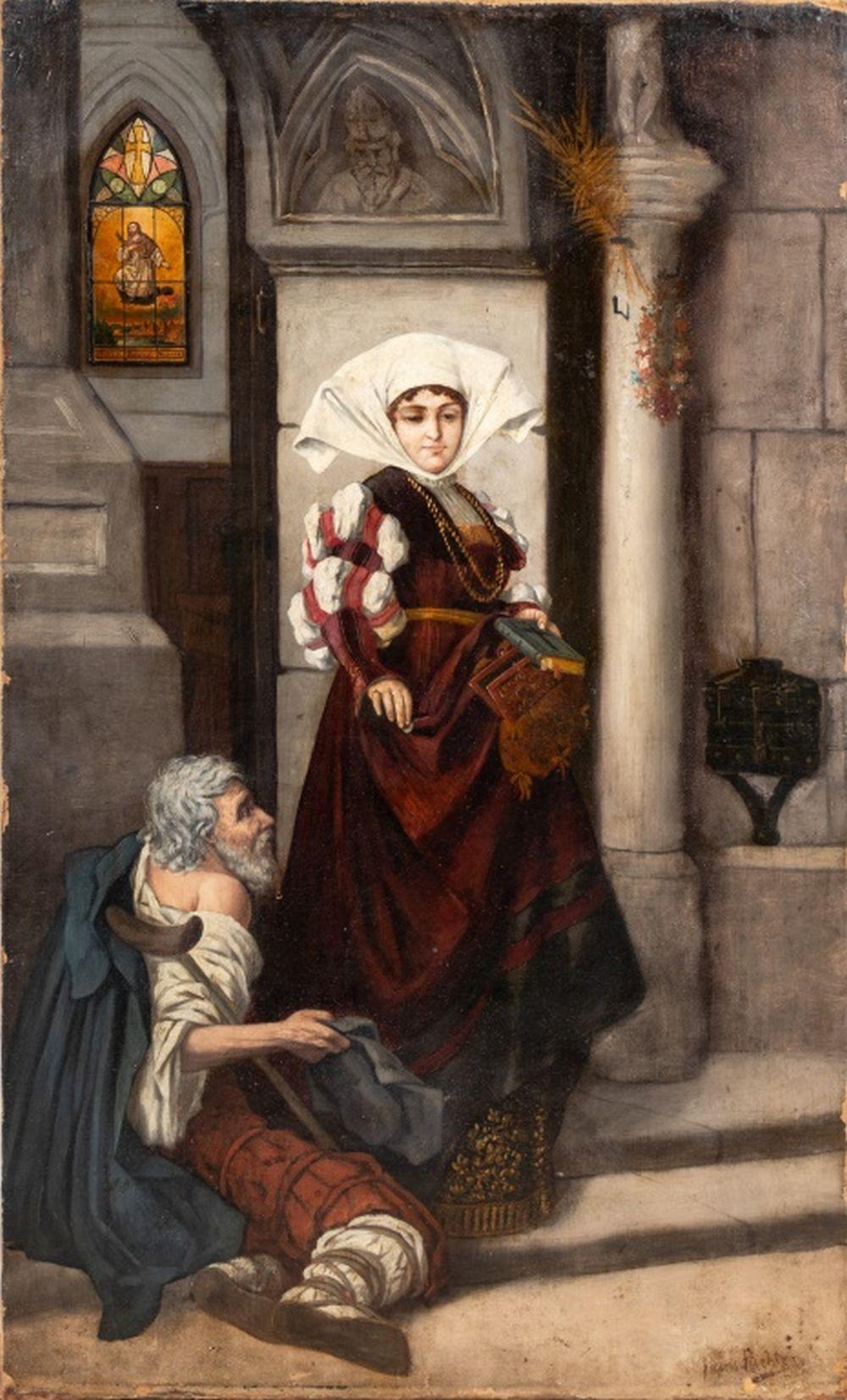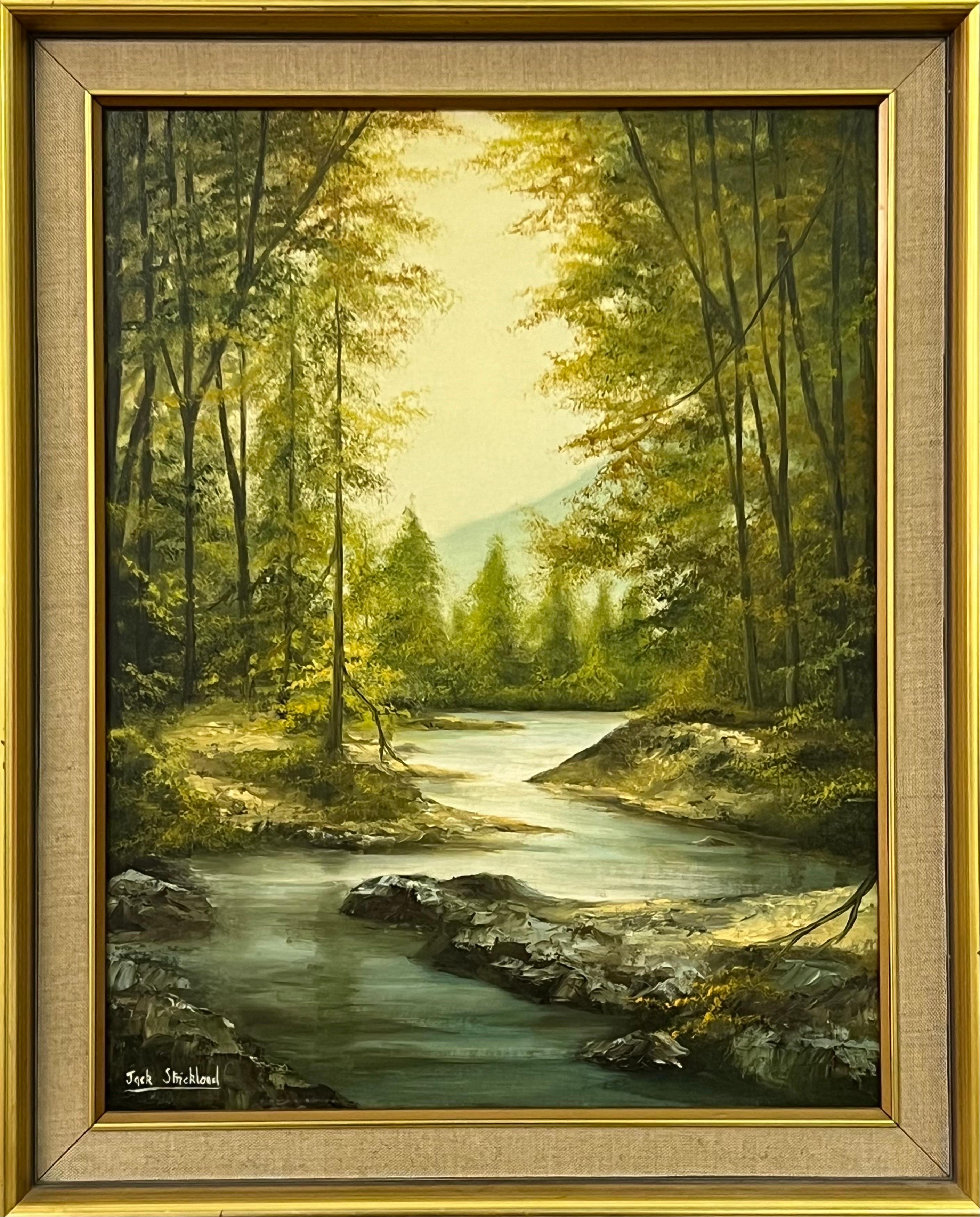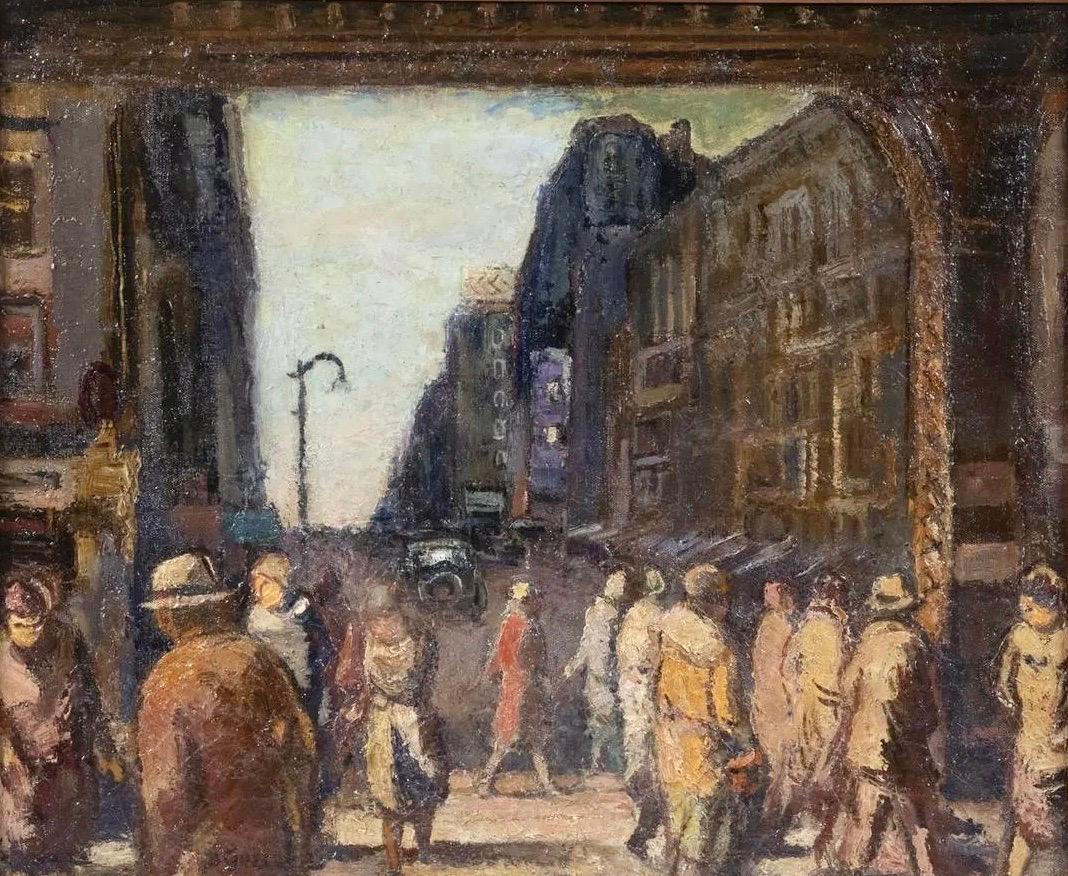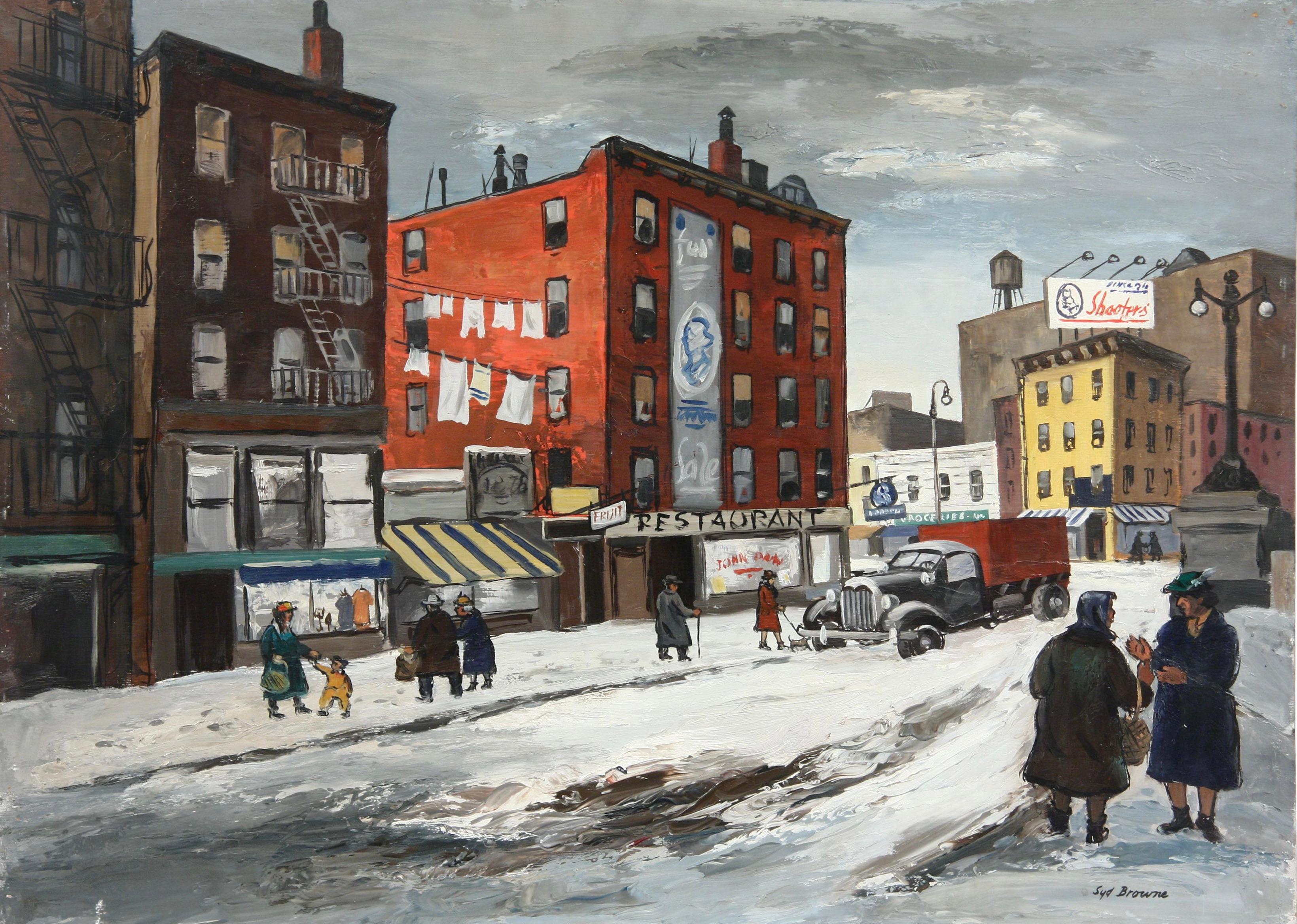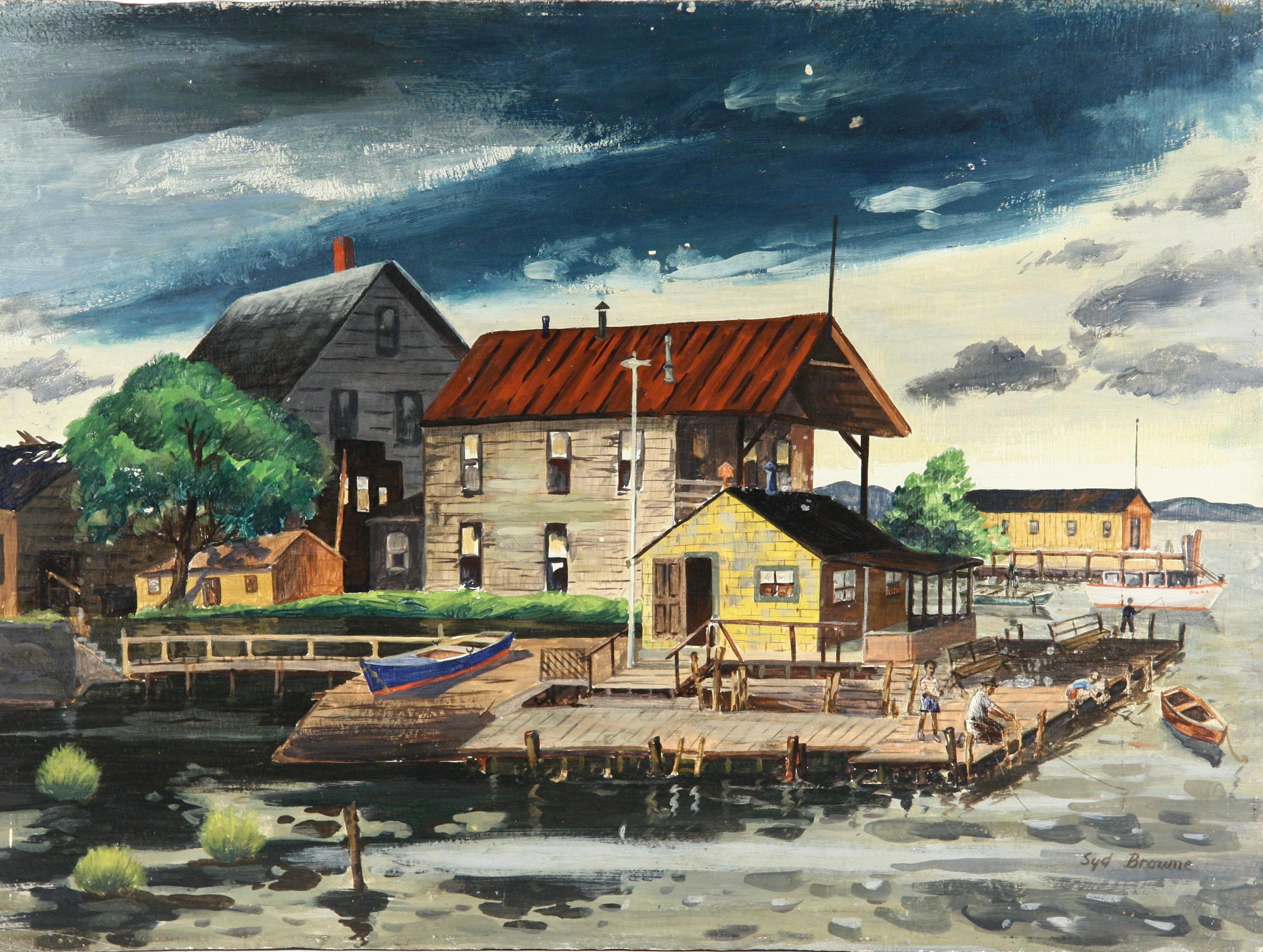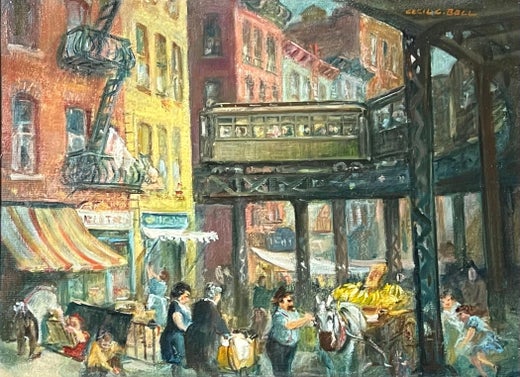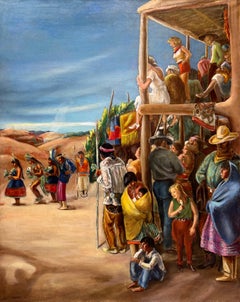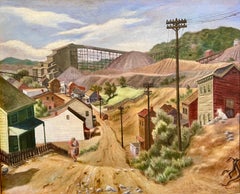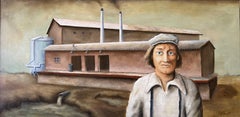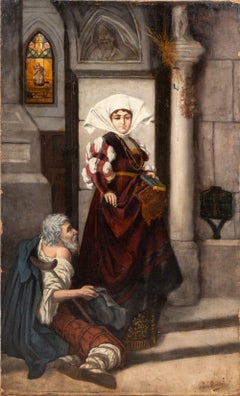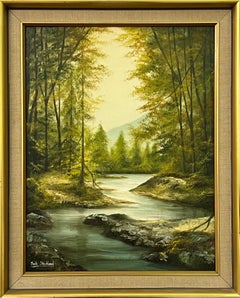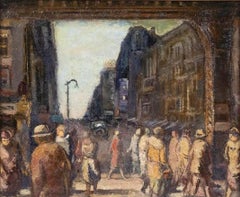Items Similar to World War II Invades Central Park
Want more images or videos?
Request additional images or videos from the seller
1 of 5
Cecil Crosley BellWorld War II Invades Central Park1943
1943
$18,000
£13,540.32
€15,685.83
CA$25,376.27
A$28,220.11
CHF 14,809.05
MX$344,130.66
NOK 187,191.58
SEK 175,499.57
DKK 117,077.13
About the Item
World War II Invades Central Park, 1943, oil on canvas, signed lower right, 30 x 36 inches, literature: Barton, Phyllis, Cecil C. Bell, McGrew Color Graphics (Kansas City, MO, 1976), pp. 78-79 (illustrated)
Bell's World War II Invades Central Park is among the artist's most significant works from the war years. Painted nine years after The Fleet's In, Bell takes on the same subject matter as Paul Cadmus' notorious painting from the inter-war period. In his evening scene, Bell portrays groups of US sailors carousing at Central Park's pond with a high rise building and the Gapstow Bridge in the background. Author Phyllis Barton further explains the context of this work:
"Exhorted by the Soldier's Handbook that 'while on pass you will be observed by civilians who will judge you by your appearance and conduct as an individual . . .,' every serviceman lived for the day when, bootcamp or tour-of-duty behind him, he would go on leave or liberty. Clutching his pass, which he had signed acknowledging the stern warning on the back, the eager GI or swab-jockey set off to dredge up some action. With the same espirit that holds armies and navies together, the fighting man geared up for his big night . . . . Most wartime Don Juans were merely boastful, but some, like the sailors pictured in Bell's World War II Invades Central Park, returned to their barracks with legitimate memories!"
This painting is a prime example of what New York Times art critic Howard Devree described in 1945 as Bell's ability to capture "with sympathy and insight divergent strains in the symphony or cacophony of New York." "Never clamorous in manner, Bell is persuasive in both color and design," Devree continued, "This is work which should attract both artists and the general public."
Cecil Crosley “Spike” Bell was an American painter, printmaker, and illustrator celebrated for his vivid depictions of urban life and everyday scenes in mid-20th century America. Born on July 15, 1906, in Seattle, Washington, Bell began his artistic career in 1925 at Tacoma Engraving. In 1928, he pursued formal studies in printmaking at the Art Institute of Chicago. In 1930, Bell moved to New York City with his wife, Agatha Lewis, immersing himself in the city’s dynamic art scene. He studied at the Art Students League under notable artists such as John Sloan, Charles Locke, Will Barnet, and Harry Wickey. During this period, he also worked as a commercial artist for Fox Films and continued freelance illustration work.
Bell’s artwork is characterized by its focus on American cityscapes and genre scenes, often portraying ordinary people in everyday situations with rich hues and a humanistic approach. His subjects ranged from bustling urban environments to rural Vermont landscapes and New Jersey beach scenes. In 1936, his growing reputation was solidified when the Whitney Museum of American Art acquired one of his paintings. Throughout his career, Bell exhibited at prestigious institutions, including the Art Institute of Chicago, the Corcoran Gallery in Washington, D.C., the Museum of Modern Art in New York, and the Tacoma Art Museum in Washington. Bell was represented by New York's Kraushaar Galleries which featured Bell in three solo exhibitions in 1945, 1952 and 1959. His works are part of several prominent collections, such as the Whitney Museum of American Art, the National Gallery of Art in Washington, D.C., the Delaware Art Museum, and the Barry Art Museum in Norfolk, Virginia.
Despite facing serious health issues in the mid-1950s, Bell continued to create art, including a six-week period in Mexico in 1961, which marked his only work executed outside the United States. He retired in 1968 and passed away on July 26, 1970, in Rutland, Vermont. After Bell's death, he was honored with a solo retrospective at the Museum of the City of New York entitled The Vanished City: Paintings of New York - 1930 - 1970. This exhibition played an important role in Bell's rediscovery by the art world, after more than a decade of benign neglect. Bell is listed in Who Was Who in American Art and all other standard references.
- Creator:Cecil Crosley Bell (1906 - 1970, American)
- Creation Year:1943
- Dimensions:Height: 30 in (76.2 cm)Width: 36 in (91.44 cm)Depth: 1 in (2.54 cm)
- More Editions & Sizes:30 x 36Price: $18,000
- Medium:
- Movement & Style:
- Period:
- Condition:
- Gallery Location:Los Angeles, CA
- Reference Number:1stDibs: LU1859216792812
Cecil Crosley Bell
Cecil Crosley Bell was born on July 15, 1906, in Seattle. Bell studied printmaking at the Art Institute of Chicago before moving to New York to study at the Art Students League with John Sloan. Bell remained in New York, eventually settling in Staten Island with his wife. Most of his paintings depict famous locations around New York City. Bell died in New York in 1970. Largely unknown during his lifetime, in 1973 a retrospective of his work was held at The Museum of Modern Art, New York.
About the Seller
5.0
Vetted Professional Seller
Every seller passes strict standards for authenticity and reliability
1stDibs seller since 2022
15 sales on 1stDibs
Typical response time: <1 hour
- ShippingRetrieving quote...Shipping from: Los Angeles, CA
- Return Policy
Authenticity Guarantee
In the unlikely event there’s an issue with an item’s authenticity, contact us within 1 year for a full refund. DetailsMoney-Back Guarantee
If your item is not as described, is damaged in transit, or does not arrive, contact us within 7 days for a full refund. Details24-Hour Cancellation
You have a 24-hour grace period in which to reconsider your purchase, with no questions asked.Vetted Professional Sellers
Our world-class sellers must adhere to strict standards for service and quality, maintaining the integrity of our listings.Price-Match Guarantee
If you find that a seller listed the same item for a lower price elsewhere, we’ll match it.Trusted Global Delivery
Our best-in-class carrier network provides specialized shipping options worldwide, including custom delivery.More From This Seller
View AllIndian Dance
Located in Los Angeles, CA
Indian Dance, 1935, oil on canvas, signed and dated lower left, 30 x 24, label verso reads: “A Kutka / Indian Dance”, title and artist’s name inscribed verso together with number “12...
Category
1930s American Realist Landscape Paintings
Materials
Canvas, Oil
Goldmine, Central City, Colorado
By Joseph Meert
Located in Los Angeles, CA
Goldmine, Central City, Colorado, c. 1936 - 38, oil on canvas, 28 x 36 inches, signed lower right; provenance includes Platt Fine Art, Chicago (label verso); likely original frame pa...
Category
1930s American Realist Landscape Paintings
Materials
Canvas, Oil
Factory Worker
Located in Los Angeles, CA
This painting is part of our exhibition America Coast to Coast: Artists of the 1930s
Factory Worker, c. 1936, oil on canvas, signed lower right, 18 ¼ x 36 inches; exhibited in City ...
Category
1930s American Realist Figurative Paintings
Materials
Oil
Knight’s Lodging
Located in Los Angeles, CA
This painting is part of our exhibition American Coast to Coast: Artists of the 1930s
Knight’s Lodging, 1941, oil on canvas panel, signed and dated lower left, 16 x 20 inches, exhi...
Category
1940s American Realist Figurative Paintings
Materials
Oil
Circus Wagons
By Millard Sheets
Located in Los Angeles, CA
This watercolor is part of our exhibition America Coast to Coast: Artists of the 1930s
Circus Wagons, 1927, watercolor on paper, signed and dated lower left, 10 x19 ¾ inches (sight), provenance includes Stary-Sheets Art Gallery (Gualala, CA); J. Ralph & Louis Stone Foundation; presented in a newer metal frame behind glazing
About the Painting
Millard Sheets was only twenty years old and in his third year of studies at the Chouinard Art Institute when he painted Circus Wagons. Despite his youth, Sheets was already an accomplished artist who had publicly exhibited his work and won prestigious prizes. Within several years, he would have his first solo exhibition at one of Los Angeles’ premiere galleries and become a painting instructor at his alma mater. In Circus Wagons we already see Sheets deft handling of the watercolor medium and his interest in the California Scene. In this case, Sheets captures a back lot view of a traveling circus, a subject he sometimes returned to, including in a color screen print in the collection of the National Gallery. Sheets made a career by painting what he knew and observed firsthand. This approach allowed Sheets to capture with authenticity the details of each narrative. Even with a narrowly limited palette and an economy of brushstrokes, Sheets effectively depicts the southern California scene with its strong and mysterious shadows, as well as the workers and circus animals. Seen through the hindsight of his six-decade long career, Circus Wagons offers a fascinating insight into the early development of California Scene painting which would by the mid-1930s become the best recognized style on the West Coast.
About the Artist
Millard Sheets was the dean of California watercolorists. His list of accomplishments is so extensive that his entry in Who was Who in American Art is over forty lines. Born in Pomona, California, Sheets became a painter at an early age, winning a prize at the Los Angeles County Fair in 1918. By the mid to late-1920s, Sheets became a regular at art exhibitions in the western part of the United States, winning several additional prizes before he reached the age of twenty-five. Sheets studied at the prestigious Chouinard Art Institute from 1925 through 1929 with Frank Tolles Chamberlin and Clarence Hinkle and had his first solo show with Los Angeles’ Dalzell Hatfield Gallery in 1929. During the 1930s, Sheets was invited to exhibit at almost every major American Museum and in many ways, his work came to represent the California watercolor school...
Category
1920s American Realist Figurative Paintings
Materials
Watercolor
Industry and Commerce
Located in Los Angeles, CA
This mural study is part of our exhibition America Coast to Coast: Artists of the 1930s
Industry and Commerce, 1936, tempera on panel, 16 ½ x 39 ½ inches, signed verso “John Ballator, Portland Ore.” provenance includes: J.C. Penney Company, represented by Russell Tether Fine Arts Assoc.; presented in a newer wood frame
About the Painting
Industry and Commerce is a prime example of WPA Era muralism. Like a Mediaeval alter, this mural study is filled with icons, but the images of saints and martyrs are replaced with symbols of America's gospel of prosperity through capitalism. Industry and Commerce has a strong narrative quality with vignettes filling the entire surface. Extraction, logistics, design, power generation, and manufacturing for printing, chemicals, automobiles and metal products are all represented. To eliminate any doubt about the mural's themes, Ballator letters a description into the bottom of the study. Ballator also presents an idealized version of industrial cooperation, as his workers, lab-coated technicians and tie-wearing managers work harmoniously toward a common goal in the tidy and neatly designed environments. Although far from the reality of most industrial spaces, Ballator's study reflects the idealized and morale boosting tone that many mural projects adopted during the Great Depression.
About the Artist
John R Ballator achieved success as a muralist, lithographer, and teacher during the Great Depression. Born in Oregon, he studied at the Portland Museum Art School, the University of Oregon and at Yale University where he received a Bachelor of Fine Art. In 1936, Ballator was commissioned to paint a mural panel for the new Department of Justice Building in Washington DC, an important project that spanned five years with several dozen artists contributing a total of sixty-eight designs. Ballator completed murals for the St. Johns Post Office and Franklin High School, both in Portland, Oregon. He also contributed to the 1938 murals at Nathan Hale School in New Haven, Connecticut. During the late 1930s, Ballator taught art for several years at Washburn College in Topeka, Kanas, where he completed a mural for the Menninger Arts & Craft Shop before accepting a professorship at Hollins College...
Category
1930s American Realist Figurative Paintings
Materials
Tempera
You May Also Like
Charity
Located in Astoria, NY
Henry L. Richter (1870-1960), Charity, Oil on Canvas, 19th century, depicting a woman giving change to an invalid inside a church, signed lower right, unframed. 32.5" H x 19.75" W.
Category
Late 19th Century American Realist Figurative Paintings
Materials
Canvas, Oil
Arctic Stream in Forest Landscape with Lush Green by 20th Century British Artist
Located in Preston, GB
Arctic Stream in Forest Landscape with Lush Greens & Blues by 20th Century British Artist, Jack Strickland
Art measures 16 x 20 inches
Frame measure...
Category
1970s American Realist Landscape Paintings
Materials
Canvas, Oil, Board
Street of the Old Quarter British School signed Cade oil on canvas painting
Located in Barcelona, Barcelona
**Technical Sheet**
**Title:** "Street of the Old Quarter"
**Author:** British School, 19th Century
**Date:** 1892
**Technique:** Oil on canvas
**Dimensions:** 14.17 x 10.63 inc...
Category
1890s American Realist Figurative Paintings
Materials
Canvas, Oil
$835 Sale Price
41% Off
Columbus Avenue NYC c. 1920s/30s American Scene Ashcan WPA Modern 20th Century
By Bernard Gussow
Located in New York, NY
Columbus Avenue NYC c. 1920s/30s American Scene Ashcan WPA Modern 20th Century
"Late Afternoon, Columbus Avenue, New York", impasto oil on canvas, signed lower left, signed verso (under relining, shown in photo), and titled verso on stretcher, in maple mitered cove frame, 23 1/4" x 27 1/4", SS: 19 1/4" x 23 1/4", Relined.
BIO
Russian-born Gussow trained at the Art Students League and the National Academy of Design. He also studied under Bonnat at the Ecole des Beaux-Arts in Paris. His first claim to fame was exhibiting two works at the Armory Show in 1913. Gussow exhibited at the Society of Independent Artists between 1917 and 1934 and at Salons of America in the 1930s.
The Whitney Museum of American Art, for example, has his Subway Stairs. The Barnes Foundation...
Category
1920s American Realist Figurative Paintings
Materials
Canvas, Oil
"Snowy City Scene" American Scene Social Realism WPA Era Mid-20th Century Modern
Located in New York, NY
"Snowy City Scene" American Scene Social Realism WPA Era Mid-20th Century Modern
Syd J. Browne (1907-1991)
"Snowy City Scene"
22 x 30 inches
Oil on canvas. c. 1930s
Signed lower lef...
Category
1930s American Realist Figurative Paintings
Materials
Canvas, Oil
"Summer Pier Fishing" American Scene Social Realism WPA Mid-20th Century Modern
Located in New York, NY
"Summer Pier Fishing" American Scene Social Realism WPA Mid-20th Century Modern
Syd J. Browne (1907-1991)
"Summer Pier Fishing"
22 x 30 inches
Oil on canvas. c. 1930s
Signed lower r...
Category
1930s American Realist Figurative Paintings
Materials
Canvas, Oil
